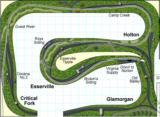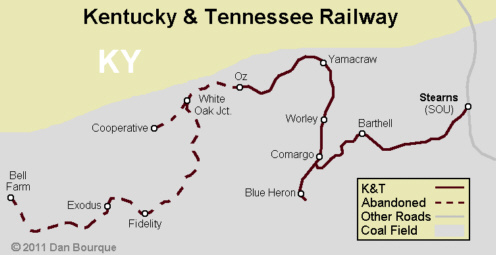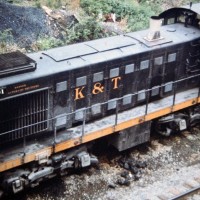
Track Plans K&T Track Plans K&T Track Plans |
Photos | Models (No K&Tmodels at this time) |
History
 The Kentucky & Tennessee Railroad was formed in 1902 to serve the timber and coal reserves of the Stearns Coal and Lumber Company. The original line was a short spur off the Cincinatti, New Orleans and Texas Pacific mainline run by the Southern Railway. After a reorganization into the Kentucky & Tennessee Railway in 1904, the line was extended along the South Fork of the Cumberland River to access the rich coal and timber resources owned by the parent company and included the classic concrete arch bridge at Yamacraw. Although there were aspirations to extend the line south into Knoxville, Tennessee, the K&T’s mainline progressed as far as Bell Farm, KY, in 1923. At Bell Farmthe road met with the 25-mile long logging railroad also owned by Stearns Coal and Lumber , and timber was hauled the 21 miles to the railroad’s origin and sawmill at Stearns, KY. The last addition to the railroad was the mile-long spur from Comargo to the “modern” coal operation at Devils Jump (Blue Heron) in 1938.
The Kentucky & Tennessee Railroad was formed in 1902 to serve the timber and coal reserves of the Stearns Coal and Lumber Company. The original line was a short spur off the Cincinatti, New Orleans and Texas Pacific mainline run by the Southern Railway. After a reorganization into the Kentucky & Tennessee Railway in 1904, the line was extended along the South Fork of the Cumberland River to access the rich coal and timber resources owned by the parent company and included the classic concrete arch bridge at Yamacraw. Although there were aspirations to extend the line south into Knoxville, Tennessee, the K&T’s mainline progressed as far as Bell Farm, KY, in 1923. At Bell Farmthe road met with the 25-mile long logging railroad also owned by Stearns Coal and Lumber , and timber was hauled the 21 miles to the railroad’s origin and sawmill at Stearns, KY. The last addition to the railroad was the mile-long spur from Comargo to the “modern” coal operation at Devils Jump (Blue Heron) in 1938.
Traffic consisted of timber to the sawmill and coal from numerous mines hauled back to Stearns to be interchanged with the Southern. The K&T also ran a modest Passenger service between Bell Farm and Stearns. At its high tide, the K&T hauled about 1,000 passengers and 3,500 tons of coal daily. Coal operations on the western end of the road at Exodus and Fidelity played out in the 1930s leaving only the timber connection at Bell Farm to keep the line open, but the lumber railroad was shut down in 1948 and the line between White Oak Junction and Bell Farm abandoned in 1949. The large mine at Cooperative was closed in 1950, and the line was cut back to Oz in 1953. Passenger service was systematically cut back following the closure of the mines until the last segment between Stearns and Worley ran its last in 1952. In 1953, the tipples at Yamacraw and Worley were closed leaving only the mine at Blue Heron and Mine 16 at Oz.
K&T operations remained similar for the next decade, and every year brought more visitors to see the eclectic steam locomotive fleet operated by the railroad. The K&T also operated a pair of fan trips for the NHRS along its “route of the painted rocks” using one of its now-rare steamers. The K&T finally dieselized in 1963 when it bought a trio of used Alco S2s from the Denver & Rio Grande Western followed by a pair of S2s bought for spare parts from other roads, one of which was returned to service as K&T 104. The last steamers, K&T #10 and #12, departed in February 1964.
Blue Heron closed in the early ’60s followed by Mine 16 at Oz in 1966 leaving only a couple of truck-dump operations loading on the line. In 1967, a brand new operation at Barthell named “Justus Mine” was opened and flood loaded about 30 Southern “Big Red” 100T hoppers per day. Trains typically consisted of three S2s and about 15 cars, but each S2 was only rated for 3 100T hoppers on the 3.5% grade up to Stearns from Barthell making for a typical loaded train of 3 diesels and 9 hoppers (the K&T never used cabooses). Justus Mine was closed in 1987, but the K&T’s legacy lives on. The Big South Fork Scenic Railway continues to operate tourist trains between Stearns and Blue Heron and perform switching at Stearns. The BSFSR uses S2s, including one of the original K&T units, to haul passengers along the banks of the Cumberland River to the restored tipple and mining museum at Blue Heron. Future plans include expanding the line back across the Cumberland on the Yamacraw Bridge, though there is no indication coal will ever be hauled over the line again.
Motive Power. The K&T’s motive power consisted of used Alco S2s which it had overhauled and outfitted for multiple-unit operations on their way to the K&T in 1963. The diesels originally wore D&RGW black and gold, but later switched to the white and burgundy scheme now worn by the BSFSR. A three-locomotive set was standard on the K&T which allowed a good rotation through the maintenance shop. Interestingly, the K&T learned about driving and maintaining Alcos from its neighbor, the Tennessee Railroad, who’s diesel fleet consisted entirely of similar Alco RS1s.
K&T Diesel Roster
| Number | Model | Lineage |
| 101 | S2 | ex-DRGW 110 |
| 102 | S2 | ex-DRGW 118 |
| 103 | S2 | ex-DRGW 119 |
| 104 | S2 | ex-D&H 3028 |
Related Products:
Sources:
- Alton Lanier, “The railroad that changed more than its motive power”, Trains Magazine, July 1974
- E. Sulzer, Ghost Railroads of Kentucky
- Big South Fork Scenic Railway website





 K&T Photo Page
K&T Photo Page
The line crosses the Big South Fork of the Cumberland River at Yamacraw. But pretty accurate account of my hometown railway.
In July 2022, 200 letters written by local men applying for jobs at the Kentucky- Tennessee Railway from 1920 -1940. These letters were donated to the Stearns Museum and have been scanned, cross referenced, and available to be printed and shared with the descendants of the men who applied for jobs at the railway. These letters are priceless mementos. Please call to find out if your relative has a hand-written or typed letter and ask for a copy if they find the letter along with the company’s response.
The letters describe the dire circumstances of the lives of the miners, lumbermen, and railway workers. Those were basically the only way men could make a living as meager as it was.
The letters were given to my Uncle John Spencer by a former employee who handed him a file box of the job applications in about 1960 after The Stearns Lumber Company closed – in about 1957-58. My grandfather, Neal Spencer worked at the Lumber company from the day it opened until the day it closed. (about 1927 until 1957-58)
Great reading about the K&T. I walked from Pickens through the tunnel and then on the trail to near Bell Farm. I stopped to hang out, get clean and cool down in the creek. I recall my wash clothe floating away. I was super lucky to wander across to find the path and then road to Bell Farm. Recall sleeping on the big rock below Bell Farm. Sorry I never made it back to finish the Fidelity to Worley section. Would love to see any photos from the area.